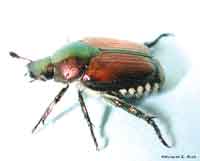 I always thought that Japanese beetle infestations were at their worst in July. Why then, are they suddenly attacking some of my roses in August?
I always thought that Japanese beetle infestations were at their worst in July. Why then, are they suddenly attacking some of my roses in August?
I’ve luckily never had too much trouble with Japanese beetles. Only a few here and there each year, whereas I hear from some gardeners that their roses and other plants are partially destroyed after a heavy infestation of the dreaded Japanese Beetles.
These nasty bugs only seem to be attacking a few of my roses. They love my Morden Sunrise in my front flower bed, and in the backyard they seem to be attacking William Baffin, Jacques Cartier, Climbing Iceberg, Baronne Prevost and Compte de Chambord. Considering how many roses I grow that’s not too bad, however these are some of my biggest roses so the damage is stating to become quite visible.
If your garden has never been attacked by Japanese beetles consider yourself lucky.
Adult Japanese beetles are 3/8 inch long metallic green beetles with hard, copper-brown wing covers. Five small white tufts project from under the wing covers on each side, and a sixth pair at the tip of the abdomen. These white tufts help to distinguish them from similar metallic green or coppery colored beetles.
Adults emerge from the ground in late May or early June. Individual beetles live about 30 to 45 days with activity concentrated over a four to six week period. Beetle numbers begin to decline in late July but some can be found as late as September.
I wonder if our cool June and rainy wet July delayed their emergence here in the Toronto area?
Japanese beetles can feed on about 300 species of plants, ranging from roses to poison ivy. Odor and location in direct sun seem to be very important factors in plant selection. The beetles usually feed in groups, starting at the top of a plant and working downward. While a single beetle doesn’t eat much; group feeding by many causes severe damage. Adults feed on the upper surface of foliage, chewing out tissue between the veins. This gives the leaf a characteristic skeletonized appearance.
I’ve also found that Japanese beetles seem to like eating rose buds and newly blooming roses.
If you don’t have too heavy an infestation of Japanese Beetles I’ve found that the best way of controlling them seems to be literally picking them off the plants and dropping them into a bucket of soapy water where they will drown.
The application of Milky Spore to the soil each year will also eventually kill off the larvae and make the likelihood of an infestation much lower.
There are pesticides that you can use if you have a heavy infestation in your garden. I prefer not to use chemicals in my garden because they often do more damage than good. I garden organically and I’ve found that dealing with pests can be quite challenging in an organic garden. I’m glad that there are always alternatives to using chemicals.
Traps can be used to attract and collect beetles however research conducted at the University of Kentucky has shown that the traps attract many more beetles than are actually caught. Consequently, susceptible plants along the flight path of the beetles and in the vicinity of traps are likely to suffer much more damage than if no traps are used at all. In most landscape situations, use of Japanese beetle traps probably will do more harm than good. If you experiment with traps, be sure to place them well away from gardens and landscape plants.
In previous years I’ve grown Four O’Clocks (Marvel of Peru) beside several of my rose bushes and it’s said that Japanese beetles do not like this plant. Perhaps that’s why I’ve never had much trouble with the darn shiny bugs. I planted my Four O’clock seeds late this year though so the plants likely aren’t mature enough to discourage the beetles.
I also used to grow garlic near my roses as that was said to help ward off Japanese beetles. I don’t grow garlic anymore as I always forgot to pick it!
Have your plants ever been attacked by Japanese Beetles? Have you seen any Japanese beetles this year? How have you handled beetle infestations?